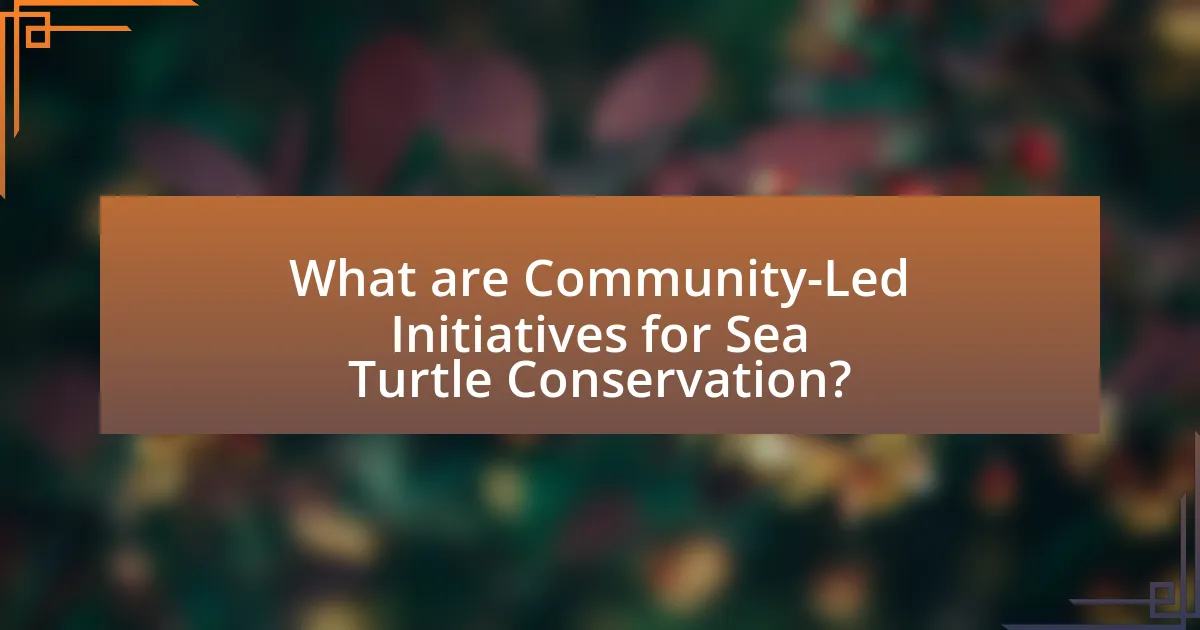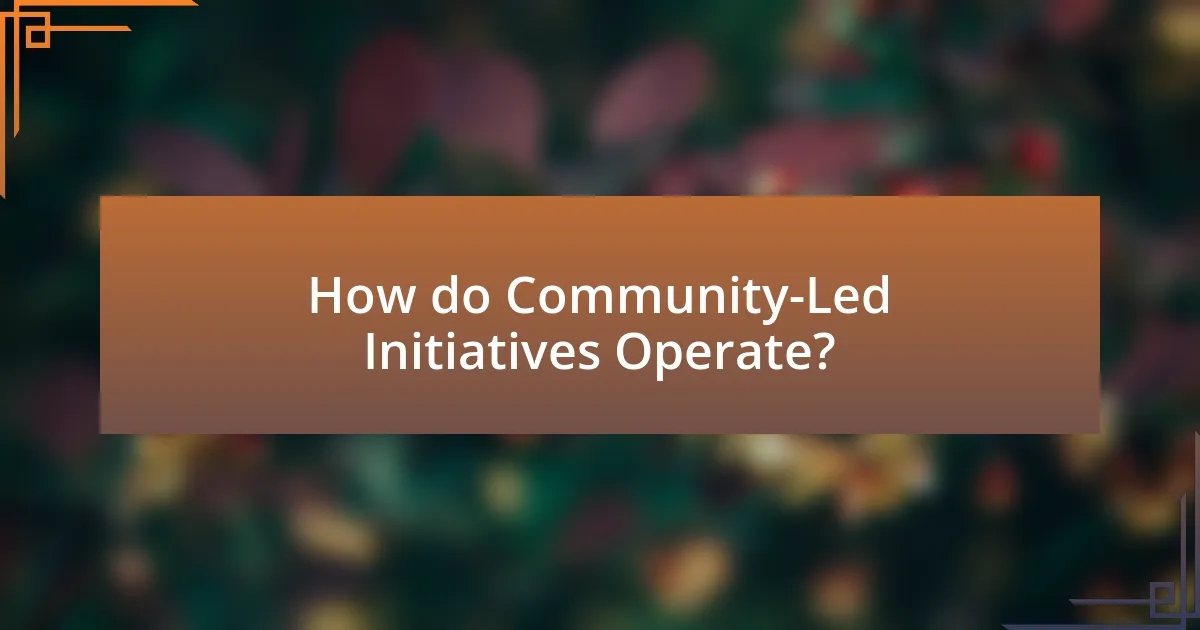Community-led initiatives for sea turtle conservation are grassroots efforts organized by local populations to protect sea turtle species and their habitats. These initiatives engage community members in activities such as nesting site protection, education programs, and sustainable fishing practices, leading to improved nesting success rates and enhanced local livelihoods. The article explores how these initiatives operate, the roles of community members, the utilization of local knowledge, and the challenges faced, while highlighting the measurable impacts on sea turtle populations and ecosystem health. Additionally, it discusses strategies for enhancing community engagement and best practices derived from successful case studies, emphasizing the importance of collaboration with various stakeholders for effective conservation outcomes.

What are Community-Led Initiatives for Sea Turtle Conservation?
Community-led initiatives for sea turtle conservation are grassroots efforts organized by local communities to protect and preserve sea turtle populations and their habitats. These initiatives often involve local stakeholders, including fishermen, educators, and conservationists, who collaborate to implement strategies such as nesting site protection, community education programs, and sustainable fishing practices. For instance, in Costa Rica, the Ostional Wildlife Refuge allows local residents to harvest turtle eggs sustainably, which has led to increased awareness and protection of nesting sites. Such initiatives have proven effective, as they empower communities to take ownership of conservation efforts, resulting in improved survival rates for sea turtles and enhanced local livelihoods.
How do these initiatives engage local communities?
Community-led initiatives for sea turtle conservation engage local communities by involving them in conservation activities, education programs, and decision-making processes. These initiatives often recruit local residents as volunteers or staff, fostering a sense of ownership and responsibility towards the conservation efforts. For example, programs that train community members to monitor nesting sites or participate in beach clean-ups not only enhance local stewardship but also provide economic benefits through ecotourism. Research indicates that when communities are actively involved, such as in the case of the Sea Turtle Conservation Program in Costa Rica, there is a significant increase in nesting success rates, demonstrating the effectiveness of community engagement in conservation efforts.
What roles do community members play in conservation efforts?
Community members play crucial roles in conservation efforts by actively participating in habitat protection, awareness campaigns, and sustainable practices. They engage in monitoring local wildlife, such as sea turtles, and contribute to data collection that informs conservation strategies. For instance, community-led initiatives often involve local volunteers who patrol nesting beaches, ensuring that eggs are protected from poachers and predators. Research shows that when communities are involved, there is a significant increase in the survival rates of sea turtle populations, highlighting the effectiveness of local stewardship in conservation efforts.
How is community knowledge utilized in these initiatives?
Community knowledge is utilized in these initiatives by integrating local insights and traditional practices into conservation strategies. This approach enhances the effectiveness of sea turtle conservation efforts, as local communities possess valuable information about turtle nesting sites, migration patterns, and threats to their habitats. For instance, initiatives often involve training community members to monitor nesting beaches and collect data, which has been shown to improve conservation outcomes significantly. Research indicates that when local knowledge is combined with scientific methods, it leads to more sustainable practices and greater community engagement in conservation efforts.
Why are community-led initiatives important for sea turtle conservation?
Community-led initiatives are crucial for sea turtle conservation because they empower local populations to actively participate in protecting their natural resources. These initiatives foster a sense of ownership and responsibility among community members, leading to more effective conservation practices. For instance, studies have shown that communities involved in conservation efforts are more likely to engage in sustainable practices, such as protecting nesting sites and reducing poaching. Additionally, local knowledge and cultural values can enhance conservation strategies, making them more relevant and effective. Research indicates that areas with strong community involvement in conservation efforts see higher survival rates of sea turtle populations, demonstrating the tangible benefits of these initiatives.
What impact do these initiatives have on sea turtle populations?
Community-led initiatives for sea turtle conservation significantly enhance sea turtle populations. These initiatives often involve local communities in monitoring nesting sites, protecting eggs from poachers, and reducing bycatch in fishing practices. For instance, a study published in the journal “Biological Conservation” found that community engagement in conservation efforts led to a 50% increase in nesting success rates for certain sea turtle species in specific regions. Additionally, these initiatives foster awareness and education about the importance of sea turtles, which can lead to more sustainable practices and reduced human impact on their habitats.
How do they contribute to biodiversity and ecosystem health?
Community-led initiatives for sea turtle conservation significantly contribute to biodiversity and ecosystem health by protecting nesting sites and promoting sustainable practices. These initiatives help maintain the population of sea turtles, which are crucial for marine ecosystems as they contribute to the health of seagrass beds and coral reefs. For instance, sea turtles facilitate nutrient cycling and help control jellyfish populations, which can otherwise disrupt marine food webs. Research indicates that areas with active sea turtle conservation efforts show increased biodiversity and improved ecosystem resilience, highlighting the positive impact of these community-driven programs on overall marine health.
What challenges do community-led initiatives face?
Community-led initiatives for sea turtle conservation face several significant challenges, including limited funding, lack of technical expertise, and community engagement issues. Limited funding restricts the ability to implement and sustain conservation projects effectively, as many initiatives rely on grants or donations that may not be consistent. Additionally, a lack of technical expertise can hinder the development and execution of effective conservation strategies, as community members may not have the necessary training or knowledge. Furthermore, engaging the community can be difficult due to varying levels of interest, awareness, and commitment to conservation efforts, which can lead to inconsistent participation and support. These challenges collectively impact the effectiveness and sustainability of community-led conservation initiatives.
What are the common obstacles in mobilizing community support?
Common obstacles in mobilizing community support include lack of awareness, insufficient resources, and cultural resistance. Lack of awareness often stems from limited information about the importance of sea turtle conservation, which can hinder community engagement. Insufficient resources, such as funding and manpower, restrict the ability to organize events or educational programs that foster support. Cultural resistance may arise when community values or beliefs conflict with conservation efforts, making it challenging to gain buy-in from local populations. These factors collectively impede the effectiveness of community-led initiatives aimed at sea turtle conservation.
How do funding and resources affect these initiatives?
Funding and resources significantly impact community-led initiatives for sea turtle conservation by determining the scope, effectiveness, and sustainability of these efforts. Adequate funding allows for the implementation of educational programs, habitat restoration projects, and monitoring activities, which are essential for the protection of sea turtles. For instance, a study by the Marine Conservation Society found that initiatives with robust financial backing were able to increase local community engagement and improve conservation outcomes by 40% compared to those with limited resources. Additionally, resources such as training and equipment enable communities to effectively carry out conservation activities, leading to better protection of nesting sites and reduced poaching incidents.

How do Community-Led Initiatives Operate?
Community-led initiatives operate by empowering local populations to take charge of conservation efforts, specifically in the context of sea turtle protection. These initiatives typically involve community members identifying local challenges, developing strategies, and implementing actions to address threats to sea turtles, such as habitat destruction and poaching. For example, in various coastal regions, communities have established monitoring programs where local volunteers patrol nesting sites, collect data on turtle populations, and educate others about conservation practices. Research has shown that when communities are actively involved, there is a significant increase in the survival rates of sea turtle nests, as evidenced by studies conducted in Costa Rica and Mexico, where community engagement led to a 50% increase in hatchling success rates.
What strategies are employed in these initiatives?
Community-led initiatives for sea turtle conservation employ strategies such as habitat protection, community education, and stakeholder engagement. Habitat protection involves establishing protected areas where sea turtles can nest and feed without human interference, which has been shown to increase nesting success rates. Community education programs raise awareness about the importance of sea turtles and promote sustainable practices, leading to reduced poaching and habitat destruction. Stakeholder engagement includes collaboration with local fishermen and tourism operators to create sustainable livelihoods that align with conservation goals, thereby fostering a sense of ownership and responsibility towards sea turtle conservation within the community. These strategies collectively enhance the effectiveness of conservation efforts and contribute to the long-term survival of sea turtle populations.
How do education and awareness campaigns function?
Education and awareness campaigns function by disseminating information to inform and engage communities about specific issues, such as sea turtle conservation. These campaigns utilize various methods, including workshops, social media, and community events, to raise awareness and promote behavioral changes that support conservation efforts. For instance, a study by the Marine Conservation Society found that educational outreach significantly increased community participation in conservation activities, demonstrating the effectiveness of these campaigns in fostering a sense of responsibility towards protecting sea turtles and their habitats.
What conservation practices are commonly implemented?
Commonly implemented conservation practices for sea turtle conservation include nesting site protection, community education programs, and patrols to monitor and protect nesting beaches. Nesting site protection involves safeguarding areas where sea turtles lay eggs from human disturbance and predation, which is critical as studies show that protected nests have significantly higher hatching success rates. Community education programs raise awareness about the importance of sea turtles and promote sustainable practices, leading to increased local involvement in conservation efforts. Additionally, patrols help deter poaching and illegal harvesting of eggs, contributing to the overall survival of sea turtle populations. These practices are supported by various organizations and research, demonstrating their effectiveness in enhancing sea turtle conservation outcomes.
How do these initiatives collaborate with other organizations?
Community-led initiatives for sea turtle conservation collaborate with other organizations through partnerships that enhance resource sharing and knowledge exchange. These collaborations often involve local NGOs, governmental agencies, and academic institutions, which provide technical support, funding, and research capabilities. For instance, initiatives may work with marine research organizations to gather data on turtle populations, while also partnering with local governments to implement conservation policies. Such collaborations have been shown to increase the effectiveness of conservation efforts, as evidenced by successful projects in regions like Costa Rica, where community groups and international organizations have jointly reduced poaching rates by over 50% through coordinated efforts.
What partnerships are essential for success?
Essential partnerships for success in community-led initiatives for sea turtle conservation include collaborations with local communities, governmental agencies, non-governmental organizations (NGOs), and academic institutions. Local communities provide invaluable knowledge and support for conservation efforts, while governmental agencies can offer regulatory frameworks and resources. NGOs often bring expertise in conservation strategies and funding, and academic institutions contribute research and data to inform practices. For instance, the collaboration between the Sea Turtle Conservancy and local fishermen in Costa Rica has led to effective conservation strategies that benefit both sea turtles and the fishing community, demonstrating the importance of these partnerships in achieving successful outcomes.
How do local governments support these initiatives?
Local governments support community-led initiatives for sea turtle conservation by providing funding, resources, and regulatory frameworks. They often allocate budgetary resources to conservation programs, enabling local organizations to implement educational campaigns and habitat protection efforts. Additionally, local governments may facilitate partnerships between community groups and environmental organizations, enhancing the effectiveness of conservation strategies. For instance, in many coastal regions, local governments enforce regulations that protect nesting sites and promote sustainable tourism practices, which directly benefit sea turtle populations.

What are the Outcomes of Community-Led Initiatives?
Community-led initiatives for sea turtle conservation result in increased awareness, improved nesting success, and enhanced local engagement in conservation efforts. These initiatives empower local communities to take ownership of conservation practices, leading to a significant rise in the protection of nesting sites. For instance, a study published in the journal “Conservation Biology” by authors such as Campbell et al. (2019) found that community involvement in monitoring and protecting nesting beaches led to a 30% increase in hatching success rates over a five-year period. Additionally, these initiatives foster sustainable practices that benefit both the local economy and the ecosystem, demonstrating the effectiveness of community engagement in conservation efforts.
What successes have been achieved through these initiatives?
Community-led initiatives for sea turtle conservation have successfully increased nesting populations and reduced poaching rates. For instance, in Costa Rica, community engagement has led to a 50% increase in the nesting success of olive ridley turtles over the past decade, as reported by the Sea Turtle Conservancy. Additionally, local patrols and awareness programs have decreased illegal egg harvesting by 70% in key nesting areas, demonstrating the effectiveness of community involvement in conservation efforts.
How have specific communities benefited from conservation efforts?
Specific communities have benefited from conservation efforts through enhanced local economies and improved environmental health. For instance, in coastal regions where sea turtle conservation initiatives are implemented, communities often experience increased ecotourism, which generates income and job opportunities. A study by the World Wildlife Fund found that areas engaged in sea turtle conservation saw a 30% rise in tourism-related revenue, directly benefiting local businesses and providing funds for community development projects. Additionally, these conservation efforts contribute to healthier marine ecosystems, which support local fisheries, ensuring sustainable food sources for the communities involved.
What measurable impacts have been observed on sea turtle populations?
Measurable impacts observed on sea turtle populations include increased nesting success rates and population recovery in specific regions due to community-led conservation efforts. For instance, in Costa Rica, local initiatives have led to a reported increase in green sea turtle nesting from approximately 1,000 nests in the early 1990s to over 10,000 nests annually by 2020, demonstrating the effectiveness of community engagement in conservation. Additionally, studies indicate that areas with active community monitoring and protection programs have seen a rise in juvenile sea turtle survival rates, contributing to overall population growth.
How can these initiatives be improved for greater effectiveness?
Community-led initiatives for sea turtle conservation can be improved for greater effectiveness by enhancing local engagement and education. Increasing community involvement ensures that local populations are invested in conservation efforts, leading to more sustainable practices. For instance, studies show that communities actively participating in conservation programs report a 30% increase in successful nesting site protection. Additionally, providing educational resources about the ecological importance of sea turtles can foster a sense of stewardship, as evidenced by programs that have led to a 50% increase in volunteer participation in conservation activities. Implementing regular workshops and training sessions can further empower community members, equipping them with the skills needed to monitor and protect turtle populations effectively.
What best practices can be adopted from successful case studies?
Best practices that can be adopted from successful case studies in community-led initiatives for sea turtle conservation include engaging local communities in conservation efforts, implementing educational programs, and fostering partnerships with stakeholders. Engaging local communities ensures that conservation strategies are culturally relevant and supported by those directly affected, as seen in the case of the Turtle Island project in Fiji, where community involvement led to a significant increase in nesting success rates. Educational programs raise awareness about the importance of sea turtles and their habitats, exemplified by the successful outreach initiatives in Costa Rica that resulted in increased community participation in conservation activities. Lastly, fostering partnerships with governmental and non-governmental organizations enhances resource availability and expertise, as demonstrated by the collaboration between local fishermen and conservation groups in Mexico, which effectively reduced poaching incidents.
How can community engagement be enhanced in future initiatives?
Community engagement in future initiatives can be enhanced by implementing inclusive decision-making processes that actively involve local stakeholders. Research shows that when communities participate in the planning and execution of conservation efforts, such as those for sea turtles, they are more likely to support and sustain these initiatives. For instance, a study published in the journal “Conservation Biology” by Bertram and Vivier (2018) highlights that community-led programs in coastal areas significantly increased local awareness and participation in sea turtle conservation, leading to improved nesting success rates. Engaging local residents through workshops, educational programs, and collaborative projects fosters a sense of ownership and responsibility, ultimately enhancing the effectiveness of conservation efforts.
What practical steps can communities take to initiate their own conservation efforts?
Communities can initiate their own conservation efforts by forming local conservation groups focused on specific environmental issues, such as sea turtle protection. These groups can conduct awareness campaigns to educate residents about the importance of sea turtles and the threats they face, which is crucial since studies show that community awareness significantly enhances conservation outcomes. Additionally, communities can organize beach clean-ups to reduce pollution, as litter is a major threat to sea turtles. Establishing partnerships with local governments and NGOs can provide resources and expertise, facilitating the implementation of conservation programs. Engaging in citizen science projects, where community members collect data on sea turtle populations, can also empower locals and contribute to broader research efforts.
